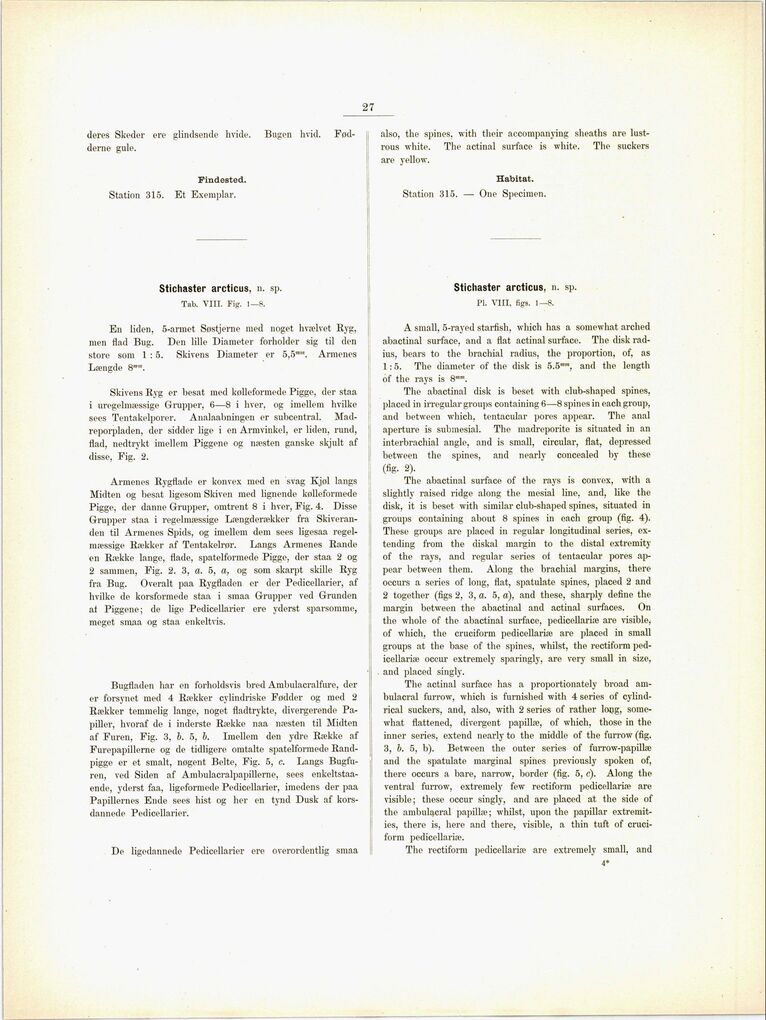
Full resolution (JPEG) - On this page / på denna sida - Sidor ...

<< prev. page << föreg. sida << >> nästa sida >> next page >>
Below is the raw OCR text
from the above scanned image.
Do you see an error? Proofread the page now!
Här nedan syns maskintolkade texten från faksimilbilden ovan.
Ser du något fel? Korrekturläs sidan nu!
This page has been proofread at least once.
(diff)
(history)
Denna sida har korrekturlästs minst en gång.
(skillnad)
(historik)
27
deres Skeder ere glindsende hvide. Bugen hvid.
Fødderne gule.
Findested.
Station 315. Et Exemplar.
Stichaster arcticus, n. sp.
Tab. VIII. Fig. 1—8.
En liden, 5-arinet Søstjerne med noget hvælvet Ryg,
men flad Bug. Den lille Diameter forholder sig til den
store som 1 :5. Skivens Diameter er 5,5""". Armenes
Længde 8""".
Skivens Ryg er besat med kølleformede Pigge, der staa
i uregelmæssige Grupper, 6—8 i hver, og imellem hvilke
sees Tentakelporer. Analaabningen er subcentral.
Madreporpladen, der sidder lige i en Armvinkel, er liden, rund,
flad, nedtrykt imellem Piggene og næsten ganske skjult af
disse, Fig. 2.
Armenes Rygflade er konvex med en svag Kjøl langs
Midten og besat ligesom Skiven med lignende kølleformede
Pigge, der danne Grupper, omtrent 8 i hver, Fig. 4. Disse
Grupper staa i regelmæssige Længderækker fra
Skiveranden til Armenes Spids, og imellem dem sees ligesaa
regelmæssige Rækker af Tentakelrør. Langs Armenes Rande
en Række lange, flade, spatelformede Pigge, der staa 2 og
2 sammen, Fig. 2. 3, a. 5, a, og som skarpt skille Ryg
fra Bug. Overalt paa Rygfladen er der Pedicellarier, af
hvilke de korsformede staa i smaa Grupper ved Grunden
af Piggene; de lige Pedicellarier ere yderst sparsomme,
meget smaa og staa enkeltvis.
Bugfladen har en forholdsvis bred Ambulacralfure, der
er forsynet med 4 Rækker cylindriske Fødder og med 2
Rækker temmelig lange, noget fladtrykte, divergerende
Papiller, hvoraf de i inderste Række naa næsten til Midten
af Furen, Fig. 3, b. 5, b. Imellem den ydre Række af
Furepapillerne og de tidligere omtalte spatelformede
Randpigge er et smalt, nøgent Belte, Eig. 5, c. Langs
Bugfuren, ved Siden af Ambulacralpapillerne, sees
enkeltstaa-ende, yderst faa, ligeformede Pedicellarier, imedens der paa
Papillernes Ende sees hist og her en tynd Dusk af
kors-dannede Pedicellarier.
De ligedannede Pedicellarier ere overordentlig smaa
also, the spines, with their accompanying sheaths are
lustrous white. The actinal surface is white. The suckers
are yellow.
Habitat.
Station 315. — One Specimen.
Stichaster arcticus, n. sp.
PI. VIII, figs. 1—8.
A small, 5-rayed starfish, which has a somewhat arched
abactinal surface, and a flat actinal surface. The disk
radius, bears to the brachial radius, the proportion, of, as
1:5. The diameter of the disk is 5.5""", and the length
öf the rays is 8mm.
The abactinal disk is beset with club-shaped spines,
placed in irregular groups containing 6—8 spines in each group,
and between which, tentacular pores appear. The anal
aperture is submesial. The madreporite is situated in an
interbrachial angle, and is small, circular, flat, depressed
between the spines, and nearly concealed by these
(fig- 2).
The abactinal surface of the rays is convex, with a
slightly raised ridge along the mesial line, and, like the
disk, it is beset with similar club-shaped spines, situated in
groups containing about 8 spines in each group (fig. 4).
These groups are placed in regular longitudinal series,
extending from the aiskal margin to the distal extremity
of the rays, and regular series of tentacular pores
appear between them. Along the brachial margins, there
occurs a series of long, flat, spatulate spines, placed 2 and
2 together (figs 2, 3, a. 5, a), and these, sharply define the
margin between the abactinal and actinal surfaces. On
the whole of the abactinal surface, pedicellariæ are visible,
of which, the cruciform pedicellariæ are placed in small
groups at the base of the spines, whilst, the rectiform
pedicellariæ occur extremely sparingly, are very small in size,
and placed singly.
The actinal surface has a proportionately broad
am-bulacral furrow, which is furnished with 4 series of
cylindrical suckers, and, also, with 2 series of rather loug,
somewhat flattened, divergent papillæ, of which, those in the
inner series, extend nearly to the middle of the furrow (fig.
3, b. 5, b). Between the outer series of furrow-papillæ
and the spatulate marginal spines previously spoken of,
there occurs a bare, narrow, border (fig. 5, c). Along the
ventral furrow, extremely few rectiform pedicellariæ are
visible; these occur singly, and are placed at the side of
the ambulacral papillæ; whilst, upon the papillar
extremities, there is, here and there, visible, a thin tuft of
cruciform pedicellariæ.
The rectiform pedicellariæ are extremely small, and
4*
<< prev. page << föreg. sida << >> nästa sida >> next page >>